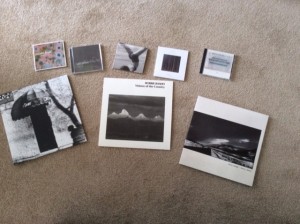Die erste CD, die ich am Neujahrstag in meinen Player geschoben habe, das war meine erste CD überhaupt. Hatte ich mich jahrelang erfolgreich geweigert, diesen Bedarfsweckungswirtschafts-Wahnsinn mitzumachen, war ich mit Erscheinen dieser CD dann eben doch weichgeklopft worden. Paul Bley, Jimmy Guiffre und Steve Swallow hatten am 16. und 17.Dezember 1989 in New York unter dem famosen Produzenten Jean-Jacques Pussiau von OWL-Records jeweils The Life of a Trio: Saturday und The Life of a Trio Sunday aufgenommen und 1990 auf den CD-Markt gebracht.

Das war es eben, diese grandiose Musik erschien nur auf CD. Mit diesen CDs fing alles an und musste dann auch schnell so weitergehen, denn Bley hatte seit 1984 eine derart kreative Phase, dass ein Werk nach dem anderen erschien. Bereits am 18.Dezember 1989 traf er sich mit Gary Peacock und nahm die CD Partners auf, ebenso unter Jean-Jacques Pussiau, so auch 1992, wo er wiederum mit Jimmy Giuffre und Steve Swallow zusammenkam, um Fly away little bird aufzunehmen. 1992 brachte ECM die erste Zusammenarbeit von Giuffre, Bley und Swallow (Aufnahme von 1961) heraus, nämlich die beiden Platten Fusion und Thesis (remixed 1990 von J.E.Kongshaug). Diese Werke erschienen bei ECM damals noch als LP (nachträglich noch ein Riesenlob an ECM, dass man dort solange noch an der LP festgehalten hat). HAT HUT Records legte dann nach und wiederveröffentlichte Giuffre, Bley und Swallow Flight, Bremen 1961, allerdings ausschließlich auf CD.
Aber zurück zu dem französischen Produzenten Jean-Jacques Pussiau. Mit ihm beendete Bley eine lange Zeit der Stille – über Jahre keine Auftritte, keine Aufnahmen oder Veröffentlichungen. Die Reihe vieler Langspielplatten von Paul Bley in meinem Plattenschrank beginnt 1953 (Paul Bley, Art Blakey und Charles Mingus) und mündet im Jahr 1978 mit der Solo-Piano-Platte Axis (aufgenommen im Juli 1977 in New-York). Dann hört man nichts mehr von Paul Bley, erst am 19.Mai 1983 geht der Meister wieder ins Studio, zu Jean-Jacques Pussiau nach Paris und nimmt dort solo die Platte Tears auf, ein Meisterwerk (OWL-Records 1984). Bereits zwei Tage später besucht Bley Mailand und spielt wiederum solo Tango Palace ( Soul Note 1985) ein; am darauf folgendem Tag (!), wir schreiben den 21.Mai 1983, trifft sich Bley mit George Cross McDonald, um eine Duo-Platte Sonor betitelt aufzunehmen (veröffentlicht 1984 bei Soul Note). Im gleichen Monat, Mai 1983, fliegt Bley nach Ludwigsburg (bei Stuttgart) und nimmt dort im großartigem Tonstudio Bauer für Manfred Eichers ECM This Earth auf, mit dabei Alfred Harth, Trilok Gurtu, Maggie Nicols und Barre Philips. Man stelle sich vor: zwischen 1977 und April 1983 Stille und dann werden im Mai 1983 gleich vier Schallplatten aufgenommen, und was für welche! Auch das Jahr 1985 ist reich an Begegnungen und Veröffentlichungen von Paul Bley, Ort der Aufnahmen ist jetzt im wesentlichen Kopenhagen: am 26.2.1985 Aufnahme für die Trioplatte Questions mit Jesper Lundgaard und Aage Tanggaard, am 17.Februar dann die bewegende Duoaufnahme mit Chet Baker: Diane und im Dezember wiederum eine Trio-Aufnahme mit Jesper Lundgaard, aber statt Aage Tanggaard drums, Billy Hart am Schlagzeug. Zwischendurch geht Bley dann noch mit John Scofield, Steve Swallow und Barry Altshul ins Mailänder Studio, um eine Platte unter dem Titel The Paul Bley Group herauszubringen.
Im Januar 1986 führen die Wege Bleysdann ins Rainbow Studio nach Oslo, wo Bley mit John Surman, Bill Frisell und Paul Motian das Meisterwerk Fragments einspielt (ECM 1986).

Am 16.März 1986 hat Bley mit Jesper Lundgaard Auftritte im Monmarte in Kopenhagen. Bandmaschinen laufen mit, veröffentlicht wird die Duo-Platte Live (SteepleChase1986), 1987 dann Live Again. Ein Jahr später wird von J.E.Kongshaug in Oslo in derselben Besetzung wie im Januar 1986 die Platte The Paul Bley Quartet aufgenommen. Im Juli 1987 spielt Bley mit Paul Motian in Mailand im Duo, heraus kommt die Platte Notes (Soul Note 1988). Zwischen dem ersten und sechsten März 1988 kann man Paul Bley, John Abercrombie, Red Mitchell und Barry Altschul im Sweet Basil in New York live erleben, die Platte Live At Sweet Basil wird aufgenommen. April 1988: Paul Bley spielt wieder in Kopenhagen, dieses Mal solo, und so lautet denn auch der Plattentitel: Paul Bley Solo Piano. Am 24.April 1989 hören wir endlich einmal wieder etwas von Jimmy Giuffre – Paul Bley ist noch nicht dabei, mit von der Partie sind Pete Levin, Bob Nieske und Randy Kaye.
Am 21.November und am 22.Dezember 1989 nimmt Paul Bley dann wieder in Kopenhagen auf, zunächst mit Ron McClure und Billy Hart im Trio die Platte The Nearness of you (SteepleChace 1989) und dann mit Bob Cranshaw und Keith Copeland die Trioplatte BeBopBeBopBeBopBeBop (SteepleChase 1990). Und damit schließt sich der Kreis, denn: am 16. und 17.Dezember 1989 war Paul Bley in New York und hatte unter Jean-Jacques Pussiau von OWL-Records jeweils The Life of a Trio: Saturday und The Life of a Trio Sunday aufgenommen. Übrigens, für die, die bisher weniger Schallplatten von Paul Bley gekauft haben: am 15.11.2013 erschien eine CD-Box mit neun überarbeiteten Platten der Firmen Soul Note und Black Saint zu einem guten Preis.






